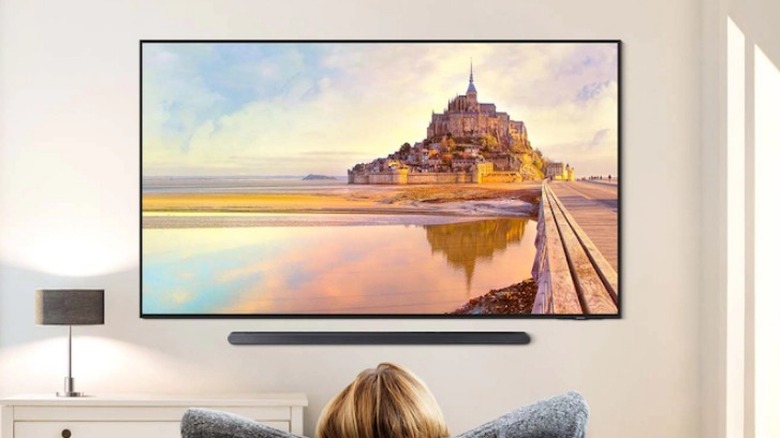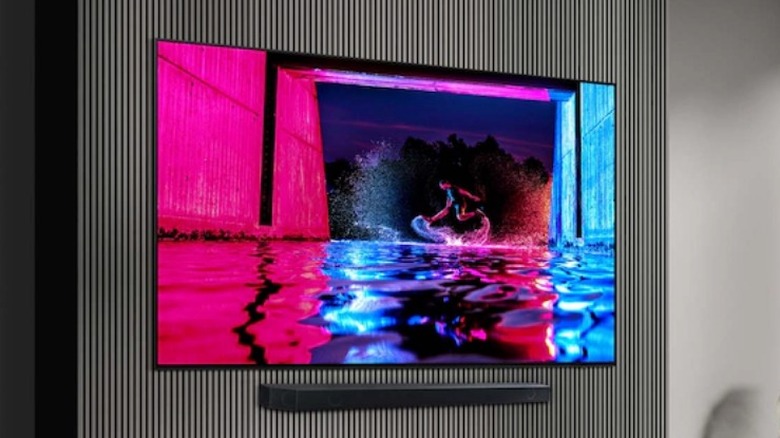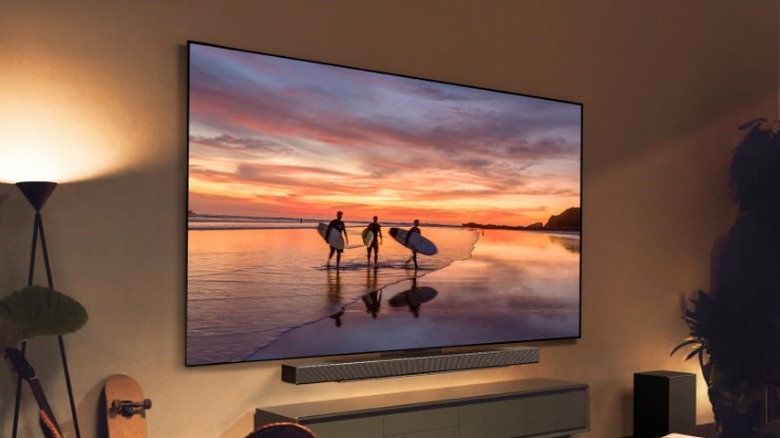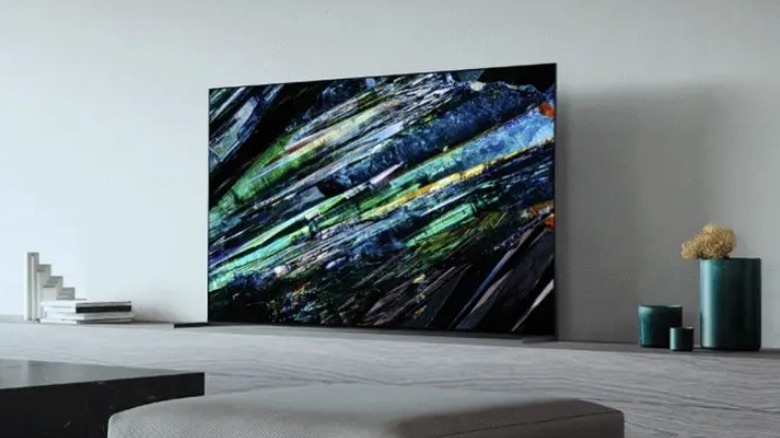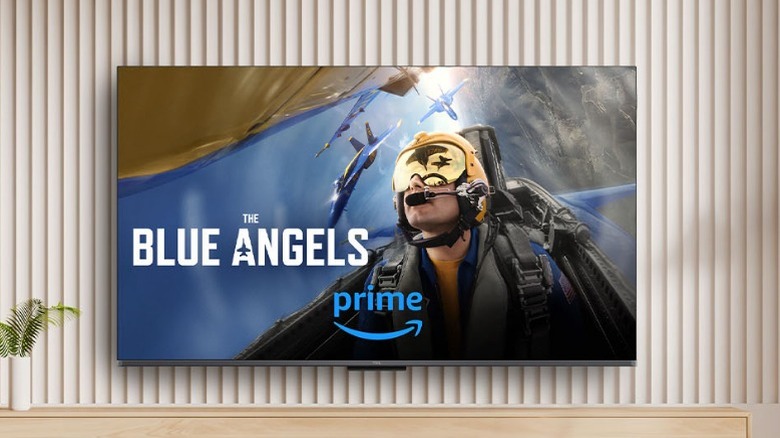6 TVs That Make Great Computer Monitors
We may receive a commission on purchases made from links.
When choosing a display for your computer, you might be tempted to get a TV instead of a traditional computer monitor. TVs tend to be much more affordable, particularly when you start to look at the 4K options versus UHD, and they're available in a wide range of significantly larger sizes. While pretty much any modern TV with an HDMI port will work with a computer, many of them might not have all the features that you find desirable in a monitor.
For example, a good computer display should have chroma 4:4:4 support for crisp-looking text, good viewing angles, and a speedy refresh rate and response time. These are specializations that are less common in televisions than they are in monitors. They're important for the user to have a good experience interfacing with their display in general, but they're particularly vital for anyone who plans on using their TV or monitor for gaming. A high-end GPU that produces hundreds of frames per second is essentially wasted on a TV with a 30-Hz refresh rate.
All of that isn't to say that you shouldn't buy a TV to use as your computer monitor; it simply means that you need to be even more selective when choosing the one you'll be using as your display. With that in mind, it might be worth checking out a few of the better options that are currently available.
Samsung QN90D QLED
Any time you look at a list of the top TV brands, you're bound to see Samsung right at the top. The company has been making TVs for decades and it has a sterling reputation for producing bright, vibrant televisions with the latest and greatest technology, so it shouldn't come as a surprise that the manufacturer has also made a couple of TVs that would double as great computer monitors.
The first of these is the QN90D QLED which was one of the highest rated Samsung TVs in 2024. This television comes in 43-, 50-, 55-, 65-, 75-, 85- and 98-inch screen sizes. It's powered by an NQ4 AI Gen2 Processor and uses Quantum Matrix Mini LED pixels which enhance both color and brightness over standard LED screens and are able to produce Neo Quantum HDR. It has Dolby Atmos and Object Tracking Sound+ for audio and offers up to a 144Hz refresh rate through a function called Motion Xcelerator, which makes it a solid pick for gamers. It also has HDMI 2.1 connectivity for a high-speed 4K connection.
"The Samsung QN90D is amazing for use as a PC monitor," said Rtings in their review. "Its incredibly low input lag means you get a responsive desktop experience, and its excellent response time means there's no noticeable blur behind quick cursor movements or when quickly scrolling through pages." They also pointed out that there are few reflections even in bright rooms, and that the chroma 4:4:4 works well for keeping text sharp. The biggest drawback they listed is a narrow viewing angle which can affect how the sides of the screen appear when you sit close to it, but they still awarded the TV an 8.9 out of 10 for its use as a PC monitor.
Samsung S90D OLED
Another Samsung model that you might want to consider is the S90D OLED. TVs with OLED screens tend to be a bit more on the expensive side, but they're often considered the best displays on the market due to their impeccable contrast ratios and super-dark blacks. However, in this case, the S90D is actually a bit cheaper than the QN90D, making it an even more attractive option.
The Samsung S90D OLED comes with OLED HDR+ and is available in 42-, 48-, 55-, 65-, 77-, and 83-inch sizes. It's powered by the same NQ4 AI Gen2 Processor, has the same Motion Xcelerator 144Hz refresh rate, and the same HDMI 2.1 connectivity as the QN90D. It also has a feature called Real Depth Enhancer that, as the name implies, creates the illusion of added dimension to the depth of the images displayed on screen. It also fixes the biggest issue most people would have with the QLED model: the viewing angle.
"Due to the TV's incredibly wide viewing angle, you can sit close to the screen, and the edges remain consistent with the center," wrote Rtings in their review where they awarded the S90 OLED a sterling 9.5 out of 10 for its use as a PC monitor. "It also has a fantastic response time, so there's no noticeable blur behind quick cursor movements or when quickly scrolling through pages, and its incredibly low input lag provides a very responsive desktop experience." They also pointed out that its peak brightness is sufficient for reflection-free viewing and that its Game Mode doesn't diminish image quality the way some other TVs do. They did point out, though, that text isn't always as clear as it could be and there is sometimes a bit of color fringing at the edges of bright windows or images.
LG C4 OLED
LG is another brand that is frequently counted as one of the premium options on the market. The LG C4 OLED is particularly nice, as it offers some great features. The TV comes in six sizes: 42, 48, 55, 65, 77, and 83 inches. These OLED Evo TVs run on an Alpha 9 AI Processor which gives it LG's AI Picture Pro and AI Super Upscaling functionalities.
Gamers will be excited to hear that this monitor not only has a 144Hz refresh rate with a 0.1ms response time but that it also has Nvidia G-Sync and AMD FreeSync Premium, which both help to match your GPU's FPS output to the display to reduce motion blur and screen tearing. Additionally, this TV has Brightness Booster tech, Dolby Vision, Dolby Atmos and a special setting called Filmmaker Mode.
"The TV has very good SDR brightness and outstanding reflection handling, so it overcomes glare in a bright room, and its nearly instantaneous response time means there's no noticeable blur behind quick cursor movements or when scrolling through pages," says Rtings. "You also get a very responsive desktop experience due to its exceptionally low input lag." The review also goes on to claim that its chroma 4:4:4 support gives it decent text-viewing, though the RWBG subpixel layout can sometimes cause minor clarity issues. They also state that it has a fantastic viewing angle. They weren't the only ones who enjoyed using it with a computer either. Parker Hall of Wired stated, "With the C4, you can plug in and play your gaming PC with equal perfection as you can with a 4K Blu-Ray player and your favorite releases."
Sony Bravia XR A95L QD-OLED
Now for the most expensive TV on our list: the Sony Bravia XR A95L QD-OLED. This TV comes in just three sizes: 55, 65, and 77 inches. It's powered by a Cognitive Processor XR that is specially designed to provide wide dynamic contrast and natural-looking colors. This is accentuated by the TV's OLED screen with its dark blacks, bright whites, and vibrant colors. It has HDMI 2.1, 4K resolution, a native 120Hz variable refresh rate, and an Auto Low Latency Mode.
All of that is impressive enough on its own, but the number of features on this TV is truly astounding. It has a Game Menu that puts gaming picture settings and features in a single, separate space, special PS5 optimization features, Dolby Vision, IMAX Enhanced, Netflix Adaptive Calibrated Mode, a Multi-View function that allows you to display multiple input sources at once, Acoustic Surface Audio+, Dolby Atmos, XR Clear Image, XR 4K Upscaling, XR OLED Motion functionality, and more. The included Bravia Cam can also automatically adjust picture and sound settings to the environment.
Rtings gave this one a 9.4 out of 10 for PC monitor performance. "The Sony A95L is a great TV for use as a PC monitor, but there are a few caveats," they said. "It has an incredibly wide viewing angle, so the sides of the screen remain uniform even if you're sitting close to the screen." According to their review, the chroma 4:4:4 works well, though this TV also suffers from color fringing around text and UI elements on the desktop. Even so, it was still counted as one of the 10 best TVs you could buy in 2024 by Consumer Reports.
Hisense U8N
So far, we've mostly been looking at the TVs with the absolute best specs for a computer monitor, but most of them are quite expensive. There are a lot of people out there who might be looking for a nice, big 4K TV that they can use as a monitor, but who aren't looking to drop four figures for one. With that in mind, it's never a bad idea to consider a few of the more affordable options out there as well.
Hisense is one of the better budget brands on the market and its U8N smart TV makes an excellent option for a computer monitor. It's an LCD Mini-LED smart display (which is another way of saying it's a QLED) powered by a Hi-View Engine Pro chipset that comes in four sizes: 55, 65, 75, and 85 inches. It has a 144Hz variable refresh rate, which is much faster than most of the other models that are available at its price point. This is made even better for gamers by the inclusion of Dolby Vision Gaming and FreeSynch Premium Pro. The U8N also comes with visual features like Dolby Vision HDR and anti-glare low reflection tech, as well as audio features like Dolby Atmos that pair with the TV's 50W 2.1.2 multi-channel audio system.
Ty Pendlebury of CNET stated that "this Hisense offered excellent contrast and maintained that fine balance between picture quality and price." Rtings points out that the TV is bright and glare-resistant, but that the viewing angles leave a bit to be desired. "The TV's incredibly low input lag provides a responsive desktop experience, and its fantastic response time means there's minimal blur behind quick cursor movements." They also point out that the chroma 4:4:4 works well.
TCL Q6 QLED
Another, even more affordable option that you might consider is the TCL Q6 (or Q65) QLED. This model admittedly isn't quite as highly rated or feature-packed as most of the others on this list, but it goes for a fraction of the price. It comes in seven different sizes: 43, 50, 55, 65, 75, 85, and 98 inches — putting it on par with Samsung in terms of range, if nothing else.
The TV is powered by a TCL AIPQ Processor that has AI functionality. It has HDR Pro+, 240 Motion Rate with MEMC (motion estimation, motion compensation), and a game mode that's designed to reduce lag. It also has Dolby Atmos and DTS Virtual:X enhancements for audio. The downside is that the Q6's refresh rate is only 60Hz. This isn't terrible for those who don't intend to game and for whom responsiveness isn't a large priority, but it's a far cry from the high speeds we see on many other TVs.
Hall from Wired stated that "TCL's game mode can upscale 1080p content to look like 120Hz, and I played my Nintendo Switch and PC through the TV just fine." Rtings says that input lag for the TV is low and that there are few issues with reflections, even in bright rooms. "Its response time is decent overall; nothing amazing, and there's some blur when moving windows around, but it looks fine overall," they state. "However, the response time is worse in dark scenes, so avoid dark mode on your operating system and in apps for an optimal experience." They also mention that the viewing angles aren't as good as they could be, and the colors may take a bit of calibration to achieve accuracy.
Our methodology
I've been a professional reviewer in the gaming and tech space for over five years. I've reviewed several monitors and am very familiar with the specifications that distinguish a display that is good for use with a computer from those that are not. Using this knowledge, I looked at some of the most popular 4K televisions that are currently on offer from the biggest brands on the market. I searched for models that had at least one advanced connectivity input, chroma 4:4:4 support, good viewing angles, and fast refresh rates and response times. I compared their specs and attempted to provide a wide range of products from multiple brands and across a spectrum of price points.
Once I had my list, I then verified their quality by looking at professional reviews, paying particular attention to reviews from Rtings and other publications that specifically mention how well these TVs perform when connected to a computer. It's worth noting that many of these TVs come in a variety of sizes and that the primary focus of this piece was on choosing models with ideal specs and features, while not focusing on the value or desirability of any specific screen size.

